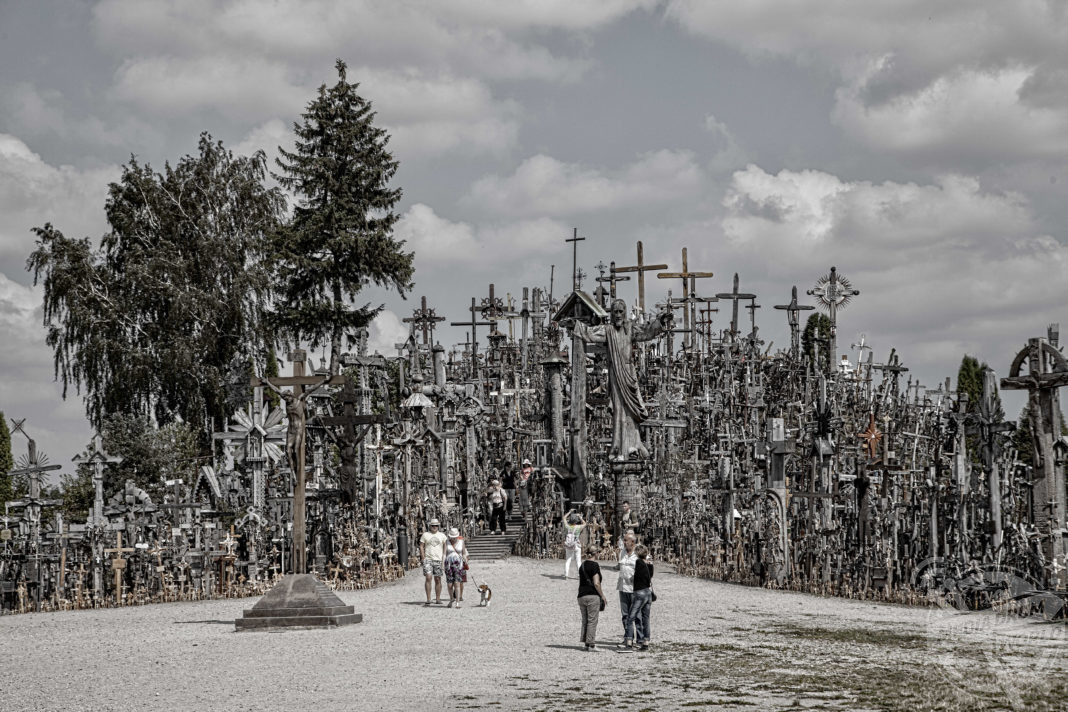By Alex Jones
REMARKABLE photographs show a haunting mountain of over ONE-HUNDRED-THOUSAND crosses, which represent over TWO-HUNDRED-YEARS of oppression in eastern Europe – but their exact origins remain a MYSTERY.
Mesmeric images capture Lithuania’s epic Kryžių Kalnas (Hill of Crosses) including a dramatic shot of countless wooden and metal crucifixes; a panoramic shot showing the scale of the remarkable national monument; and an eerie woodcarving of Jesus, draped in rosary beads.
The tale of the Hill of Crosses is an intriguing one, dating back to early stages of the 19th century. Located just outside Lithuania’s fourth largest city Šiauliai, the mound attracts thousands of pilgrims every year who visit the eerie site to pay their respects to the dead, pray, or to leave a set of rosary beads or another cross to the ever-massing collection of religious icons.

Dutch photographer Anne-Marie Vermaat (52) was fascinated by the bizarre collection where, according to local legend, an apparition of the Virgin Mary once held the baby Jesus aloft whilst surrounded by crosses. In 1993, Pope John Paul II visited the hill and called it “a place for hope, peace, love, and sacrifice”.
“There is a heavy atmosphere at the Hill of Crosses, but also a sense of persistence and hope,” said Vermaat, a Federation Internationale de L’ Art Photographique (FIAP) accredited photographer.
“You can feel the history of this special site. Nobody knows for sure, but it is generally assumed that the first crosses were placed on the hill after the November Uprising (1830-1831) when it was used as a defensive post.
“Over the centuries not only crosses were placed here, but also large crucifixes, engravings of Lithuanian patriots, images of the Virgin Mary and thousands of small images of saints and prayer chains. This has been and continues to be done by Catholic pilgrims today. The exact number of crosses on the hill is unknown, but it is estimated at 100,000, although a visitor to the hill would soon assume more than a million.”

Mention of the Hill of Crosses dates back to approximately 1850, but it appears that the crosses were left by mourning relatives of the victims of revolts against the Russian regime in 1831, and later in 1863. Religion was banned and families of the fallen were not allowed to conduct burial ceremonies, so the Hill of Crosses expanded in defiance of Lithuania’s totalitarian overlords.
During the Soviet era, religion remained banned and the Hill of Crosses off limits. In April 1961, the entire site was bulldozed and burned down by the authorities. Even though the Hill of Crosses was destroyed four more times, each time locals risked their lives to rebuild the site in secret, usually under the cover of darkness. When crosses continued to appear the soviet authorities stationed KGB agents around the site to stop people sneaking through the forest to add to the collection – yet still the tradition continued.

Following the collapse of the Soviet Union in 1991, Catholicism has been practiced openly in Lithuania and the Hill of Crosses has become a tribute to the country’s turbulent past, its steadfast beliefs, and those who died in the fight for Lithuanian freedom. Crosses vary in size and material, some fitting in your hand whilst others soar to over three metres tall.
Vermaat believes that her photos of the thought-provoking Lithuanian monument will be viewed differently by everyone who sees them.

“I mainly shoot on intuition, and I don’t want to force the viewer on an opinion or idea,” said the 52 year-old, who uses the Instagram handle @vermaat.annemarie.
“I hope that everyone can get their own story out of it. And the best thing for a photographer is if you can convey an emotion or feeling – that can be beauty or ugliness, wonder, tension, or humour. With these photo series I want to show the history of this place, and the bad and the good that man is capable of.
“It is a beautiful place, so it is not too difficult to take good pictures of it.”







